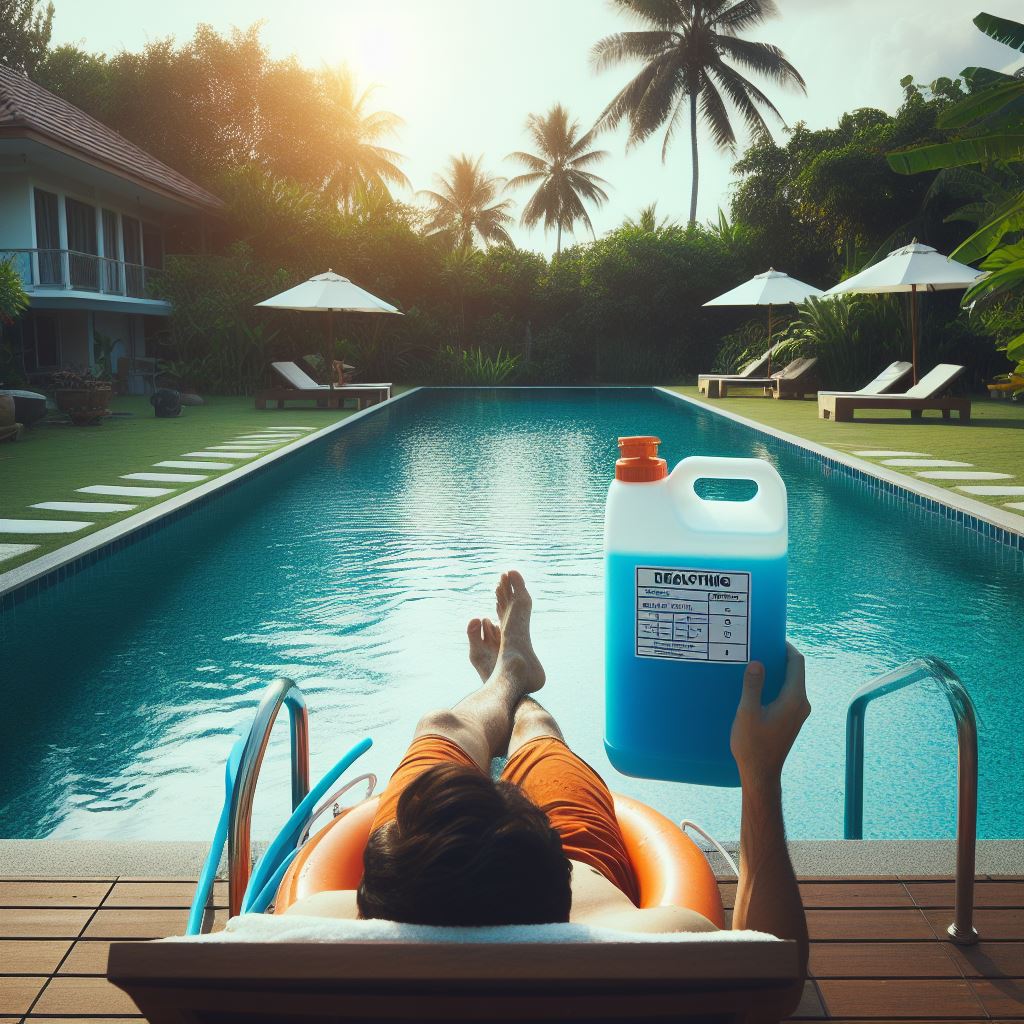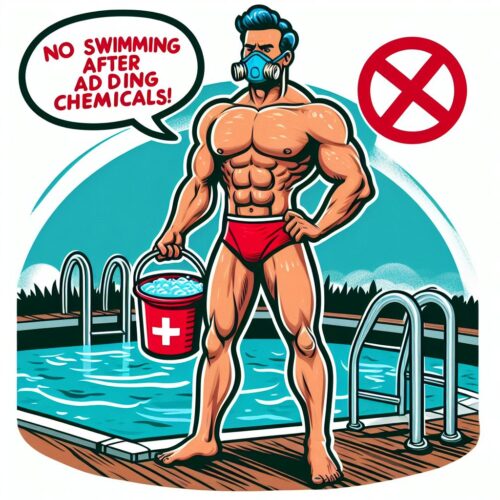The Science of Swim Wait: How Long Before Diving in After Pool Chemical Treatment
Maintaining a crystal-clear swimming pool is an art, and part of that art is the science of the right chemical balance.
But once you’ve added those chlorine tablets, balanced the pH, and given your pool a good shock, can you head in for a refreshing dip right away?
In this comprehensive guide, we’ll dive deep into the duration you need to wait before swimming in your pool after chemical treatment — an often overlooked yet critically important aspect of pool care and safety.
The Post-Chemical Dip Dilemma
The hazy line between ‘ready to swim’ and ‘watch out for the chemicals’ is a common conundrum for pool owners.
While chemical treatments are essential for a safe and sanitized swimming pool, using the pool too soon after adding certain chemicals can pose health risks and lead to less effective treatment.
The question is, what factors determine the waiting time, and how can you ensure both the pool’s and your family’s safety?
Let’s break down the types of chemical treatments, their effects, and the factors influencing the waiting game.
We’ll also recommend waiting periods and safety precautions, ensuring your swimming pool offers joy without any “wait”-ing.
Find All The Pool Chemicals You Need On Our Amazon Storefront!
Chemical Treatment and Its Effects on the Pool
Before we can calculate the waiting period, it’s crucial to understand the chemicals at work and their effects.
Common Pool Chemicals and Their Purpose
Chlorine
Chlorine is the workhorse of pool sanitization.
It destroys bacteria and algae, oxidizes dirt, and keeps your water clear.
Available in various forms, including tablets, granules, and liquid, chlorine is a mainstay of pool maintenance due to its effectiveness and cost-efficiency.
pH Balancers (Soda Ash and Muriatic Acid)
Maintaining the right pH is vital for chlorine’s efficacy and swimmer comfort.
High pH can lead to scaling, while low pH can cause corrosion and skin irritation.
pH adjusters, like soda ash for increasing pH and muriatic acid for reducing it, help keep the water balanced.
Alkalinity Adjusters (Sodium Bicarbonate)
Alkalinity acts as a buffer for the pH, helping to maintain its stability.
Adding sodium bicarbonate, or baking soda, increases the alkalinity and reduces pH fluctuations.
Shock Treatments (Calcium Hypochlorite and Non-Chlorine Shock)
Periodic “shocking” of the pool involves adding a large dose of chlorine to kill off bacteria and algae that regular chlorination might have missed.
This process also helps get rid of swimmer waste and other organic contaminants.
Each of these substances plays a vital role in pool cleanliness, but they also bring about changes that require time to normalize.
How Chemical Treatment Affects Water Quality and Cleanliness
When you introduce chemicals into your pool, several changes occur:
- pH and alkalinity fluctuation: Every time you add a chemical to your pool, you potentially alter the pH or alkalinity levels.
- Chlorine spike: Shock treatments and high doses of regular chlorine can create a temporary ‘chlorine spike’, where levels are unsafe for swimming.
- Water clarity: As chemicals work their magic, the water might get cloudier before it gets clearer, especially after adding a flocculant or clarifier.
Understanding these changes is the first step in determining the gap between pool treatment and pool playtime.
Factors Affecting the Waiting Period
Several factors come into play when calculating the waiting period after a chemical treatment.

Type of Chemicals Used
Each chemical has its own set of risks and post-treatment behavior.
Some chemicals are designed to rapidly dissipate and return the water to its safe state quickly, while others require not just time but also specific conditions to work effectively.
Dosage and Concentration
The amount of chemical added, or dosage, directly affects the waiting time.
Higher doses, especially in shock treatments, can create a more pronounced impact that takes longer to neutralize.
Water Temperature
Warmer water facilitates the activity of chemicals, which can lead to a faster turnaround.
However, high temperatures can also increase evaporation, so the water might clear quicker, but the chemicals will also dissipate sooner.
Pool Size and Volume
The larger the pool, the more dispersed the chemical concentrations.
This dispersion aids in the overall dilution process, effectively reducing waiting times.
Get A Total Pool & Hot Tub Course Bundle!Get all four pool and hot tub courses including The Pool Care Video Course, The Hot Tub Video Course, Money-Saving Guide for Pool Owners, and the Pool Winterization Course for one low price!
Recommended Waiting Periods for Chemical Treatments
Understanding the post-chemical behavior and the influencing factors, let’s outline the recommended waiting periods for common pool treatments.
Chlorine-based Treatments
- For regular pool use with standard chlorine levels, waiting 8–24 hours is typical.
- After shocking, it’s best to wait 24–48 hours before swimming to allow harsh chlorine levels to return to normal.
Saltwater Pool Systems
Saltwater systems continuously generate chlorine, with more consistent levels. Typically, waiting 4–8 hours after adding salt to the pool or a chlorine boost is sufficient.
pH Balancing and Alkalinity Adjustments
- After adding pH increaser or decreaser, waiting 1–2 hours is usually enough.
- For alkalinity adjusters, 2–4 hours should be adequate.
Shock Treatments
The waiting game is much longer after a shock. Plan for 24–48 hours so the high chlorine levels dissipate, and the water returns to a safe level for swimming.
Safety Precautions During the Waiting Period
While waiting, it’s critical to take safety precautions to keep your pool from turning risky.
Importance of Following Instructions
Always adhere to the instructions provided with pool chemicals.
They are specifically designed to keep you and your pool safe.
Potential Risks of Using the Pool Too Soon
Jumping in before the wait is over can lead to skin and eye irritation, allergies, and, in more severe cases, respiratory issues.
In the water, premature swimming could also damage your swimwear or leave a strong chlorine smell.
Tips for Ensuring Water Safety and Hygiene
Test the chemical levels before swimming to ensure they are back within the recommended ranges.
Use a pool test kit to measure chlorine, pH, and alkalinity levels.
Also, ensure there is proper pool circulation, filtering, and skimming for an added layer of safety.
Tips for Reducing Waiting Time
You can take proactive steps to reduce the waiting time and return to swimming sooner.
Proper Maintenance and Regular Testing
Keep to a diligent pool maintenance schedule.
Regular water testing allows you to catch chemical imbalances early, making it easier to correct them and reducing the waiting time after treatment.
Using Fast-Acting Chemical Products
Some chemical products are designed for faster action.
For instance, there are quick-dissolving shock treatments that can restore a neutral chlorine level more rapidly.
Seeking Professional Advice
If you’re not sure about a treatment or its post-effects, don’t guess.
Seek advice from pool maintenance professionals, who can guide you on the right path forward.
Conclusion
The duration you need to wait before using your swimming pool after chemical treatment is the pivot between a safe and sanitary swimming experience and potential hazards.
By understanding the effects of chemicals, the influencing variables, and the associated risks, you can navigate this important aspect of pool maintenance with confidence.
Don’t let impatience spoil the pool party; give your chemicals the time they need to work, and you can dive in with peace of mind.
Remember, a little “wait” goes a long way in ensuring your pool is always a refreshing source of enjoyment.
Thank you for taking the time to read through this informative guide on pool maintenance post-chemical treatment.
We appreciate your commitment to safety and sanitation when it comes to enjoying your swimming pool.
Now, we’d love to hear from you.
What has been your experience in managing your pool’s chemical balance?
Do you have any unique tips or tricks you’ve discovered along the way?
Feel free to share your experience!
Stay Safe!
“Full transparency: Our website features affiliate links. If you make a purchase through these links, we’ll earn a modest commission at no additional cost to you. This is an effortless way to support our commitment to delivering top-notch content.”



